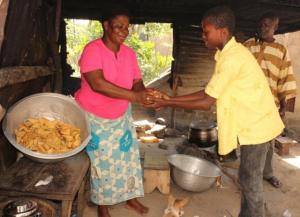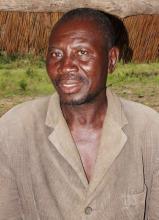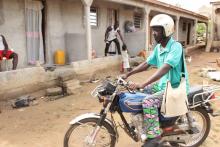Togo is Saying Goodbye to Elephantiasis
No longer ashamed
Mr. Tchazimon Essohanani, 58, is a father of six and principal of a secondary school in Bebeda, 35 km east of Kara, Togo’s second biggest city.
Essohanani recalls that in 2009, his scrotum and testicles, for no apparent reason, suddenly began to grow bigger and bigger, causing him to suffer embarrassment, shame and frustration due to the stigma. “I have 592 pupils in my school. Everywhere I went, I could ‘feel’ that all eyes were on the bulging part of my trousers. Very often, my wife asked me questions to which I had no answers,” he says.
In March 2012, Essohanani sought help at Togo’s University Teaching Hospital where he was diagnosed with hydrocele –fluid-filled, balloon-like enlargement of the sacs around the testes. Hydrocele is one of the symptoms of elephantiasis, also known by its medical name, lymphatic filariasis (LF), a mosquito-borne disease. A mosquito that bites an infected person picks up the worm larvae and injects them in the next person it bites. The disease itself is caused by thread-like worms that live in the lymphatic system, causing fluid to collect, and creating swelling, in the arms, legs, breasts or genitals. Essohanani decided to go for surgery on 13 June 2012. “It was a painless procedure’’, he recalls. “Now I am as fit as a fiddle. The feeling of shame and embarrassment is gone. My confidence has been restored. I am happy and still on my job.’’
Back in business: early diagnosis and treatment key to good outcomes
Madam Kamazoue Abatan, 55, a food vendor and mother of four came down with what at first seemed like a cold with fever in January 2004 at Dongoyo, a suburb of Kara. The symptoms quickly went away, but little did she know that she had been infected with the parasite that causes lymphatic filariasis (LF), also known as elephantiasis. “As time went on, my lower limbs got bigger and bigger until they were several times their normal size, and my business suffered”, she recollects. A test conducted at the Kara General Hospital confirmed Madam Abatan was positive for elephantiasis. She was immediately enrolled in a national programme set up to manage LF patients. “Today, my two feet are their normal size and I am back, busy at my trade”, she says, with a sense of relief. Her story has a happy ending because of early diagnosis and treatment.
The present conditions of Mr Essohanani and Madam Abatan are pointers to another unfolding African health success story: Togo is on the threshold of making history as the first country in sub-Saharan Africa to eliminate LF.
In 2000, seven of Togo’s 35 health districts were endemic for LF. Today, the country is on the verge of being certified as LF-free by the World Health Organization (WHO), after prevalence data suggested that LF disease transmission had been interrupted in the country in 2010.
How was this remarkable feat achieved?
The Director of Togo’s National Lymphatic Programme for the Elimination of Filariasis (NPELF), Dr Ameyo Dorkenoo, says that her country adopted the two-pronged strategy of: (a) interrupting transmission and preventing occurrence of new transmissions; and (b) treating or managing disease due to LF, and then simply played by the rules, using the WHO- recommended stepwise approach for LF elimination.
In her words: “In 2000, Togo established the NPELF, conducted surveys to determine where active transmission was occurring including the population at risk, and, therefore, areas in need of mass drug administration (MDA) [1]. These surveys were followed by at least five years of MDA and a period of post-MDA surveillance. Now, we are awaiting verification by WHO, in 2015, of absence of the transmission of the disease in our country.”
According to Dr Dorkenoo, the initial surveys showed that seven districts with a population of 1.2 million were at risk. The first MDA was conducted in 2000 in the district of Binah, and, within three years, the mass distribution of drugs scaled up to all seven endemic health districts. Between 2000 and 2009, the country conducted six to nine rounds of MDA in each LF-endemic district. Now, records show that since 2007, reported and verified drug coverage has exceeded 80% of the total population (WHO’s recommendation is 70%). The distribution and uptake of drugs have succeeded in reducing levels of the disease-causing parasites to a point where they are no longer detected in tested persons living in all districts that were LF-endemic in 2000.
Dr Dorkenoo explains that the campaign to eliminate LF in Togo is not based on curing those who already suffer from it. Instead, it is based on giving people drugs that kill the larvae, and therefore prevent transmission from those who have it to those who don’t. A ‘star’ component of Togo’s success is the use of a two-drug treatment programme – Albendazole and Ivermectin which kill over 99% of the disease-causing parasites within hours, thus breaking the transmission chain. This dual drug programme also has collateral health benefits: while the former kills five intestinal worms, the latter stops scabies and kills mice.
Surveillance has been another key success factor in interrupting LF transmission in Togo, reputed to be the first to implement a nation-wide LF surveillance system. Dr Dorkenoo explains that the institution of a system to identify and track cases with active infection has yielded astounding results. Indeed, since post-MDA surveillance is crucial for monitoring resurgence of infection or importation, NPELF is continuing to monitor data from 46 laboratories and 18 dispensaries geographically dispersed throughout the country, including in districts considered non-endemic for LF after the 2000 mapping.
She sums up the other success factors that are seeing Togo making history: “Our population is small (just 6.1 million), Government has demonstrated uncommon political commitment, our committed and motivated community health workers have shown fantastic zeal, and partnerships with strategic and generous partners have worked well”. The last point is a reference to the technical support provided by WHO and the US Centres for Disease Control, and the financial support provided by Norway’s Health & Development International, among others. The country’s ability to recognize and capture financial funding opportunities is demonstrated by the fact that Togo remains the only LF programme in the world to be awarded financial support for LF prevention and control by the Global Fund to Fight AIDS, Tuberculosis and Malaria.
Success in the implementation of the second pillar of Togo’s LF elimination strategy –treating and managing disease due to LF – is attested to by the training of more than 20 doctors in hydrocele surgery, the more than 350 surgeries so far carried out, and the fact that people affected by LF are being reached through the country’s LF disability management programme as part of home-based care and through changing of attitudes of communities. With knowledge and proper self-care, many Togolese LF patients are experiencing drastic improvements in quality of life and productivity.
LF patient 46-year old Bale Essonani, a teacher and father of five, living at Lama Kpedah, on the outskirts Kara, still has swollen legs, but remains a living example of how adherence to recommended practices for managing disability due to LF can lead to ‘stability’ and the living of a normal life. “I have never felt better in this life”, he enthuses. I live a normal life, enjoy respect and support from my pupils, family and friends who now know that my condition has been caused by a mosquito bite. Visits and counsel by WHO officials have been a great inspiration”, he says. “I may be chronically ill, but I take solace in the fact that my children and their children will live a life free of ‘big foot’, as elephantiasis is called in parts of West Africa.
In this respect, the words of WHO Representative in Togo, Dr Lucile Imboua, are more than reassuring: “We are delighted to have come this far. WHO and other partners will continue to provide Togo with the necessary support to consolidate the achievements so far recorded, and ensure that good management of chronic LF illness, which typically persists even after LF transmission has been interrupted;”
[1] Mass drug administration is the administration of drugs or medicines to entire populations, irrespective of disease status, in order to control, prevent or eliminate common or widespread disease.
Related video
Below:
01 - Tchazimon Essohanani, Secondary School Principal. He underwent a successful hydrocele surgery.
02 - Madam Kamazoue Abatan, food vendor. She is a beneficiary of early diagnosis and prompt treatment.
03 - Bale Essonani, teacher. Infected with LF but stable and living a normal life following good management practices.
04 - Dr Lucile Imboua, WHO Representative in Togo.
05 - Dr Ameyo Dorkenoo, Director of Togo’s National Lymphatic Programme for the Elimination of Filariasis.









